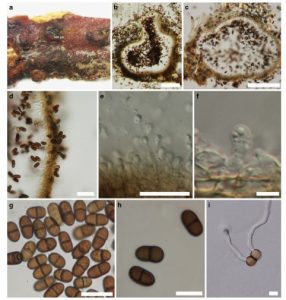Paracamarosporium tamaricis Thambugala, Camporesi &K.D. Hyde, sp. nov. Index Fungorum number: IF552094
Etymology: The species epithet ^tamaricis^ refers to the host genus Tamarix on which the holotype was collected.
Holotype: MFLU 16–0661
Saprobic on Tamarix gallica L. Sexual morph: Undetermined. Asexual morph: Conidiomata 280–350 μm diam. × 160–320 μm high (x = 311 × 237 μm, n = 6), pycnidial, single to solitary, or scattered, immersed, brown to dark brown, globose to subglobose, ostiolate. Conidiomatal wall 15–35 μm wide, comprising several layers of light brown cells of textura angularis, becoming hyaline towards the conidiogenous region. Conidiophores reduced to conidiogenous cells. Conidiogenous cells 3–9.2 × 2.2–4.4 μm (x = 6.5 × 3.2 μm, n = 15), hyaline, smooth, holoblastic forming conidia at their tips. Conidia 8.9–12.1 × 4.5–6.4 μm (x = 10.2 × 5.2 μm, n = 40), initially hyaline, becoming pale brown to brown, oblong to sub-cylindrical, with rounded ends, 1-septate, smooth-walled.
Culture characteristics: Conidia germinating on PDA within 24 h and germ tubes produced from one or both ends. Colonies growing on PDA 15 mm diam. After 14 days at 25 °C, circular, flat, moderately dense, surface white, becoming pale brown when aged, smooth surface, with entire to slightly undulate edge.
Material examined: ITALY, Province of Forlì-Cesena, Converselle – Castrocaro Terme e Terra del Sole, dead branches of Tamarix gallica L. (Tamaricaceae), 24 December 2014, Erio Camporesi IT 933 (MFLU 16–0661, holotype), ex-type living culture MFLUCC 15–0494, ICMP; ibid. (MFLU 16–0662, isotype); ibid., 22 January 2015, Erio Camporesi IT 933–2 (MFLU 16–0662, paratype), living culture MFLUCC 15–0495.
Notes: Paracamarosporium tamaricis is introduced to accommodate a new paraconiothyrium-like species, based on phylogeny and new taxonomic concepts of Paracamarosporium (Crous et al. 2015). In our phylogenetic analysis, P. tamaricis (strains MFLU 16–0661 and 16–0662) clustered in a separate clade in Paracamarosporium and is phylogenetically distinct from Paracamarosporium hawaiiense and P. fagi (Fig. 19), the other paraconiothyrium-like species in Paracamarosporium. This is the first report of Paracamarosporium species on Tamarix species.
FIG. Paracamarosporium tamaricis (holotype) a Appearance of conidiomata on host surface b, c Vertical section through conidiomata d Conidiomatal wall e-f Conidiogenesis and developing conidia g-h Conidia i Germinating conidium. Scale bars: b, c = 100 μm, d = 25 μm, e = 20 μm, f = 5 μm, g = 15 μm, h- i = 10 μm

